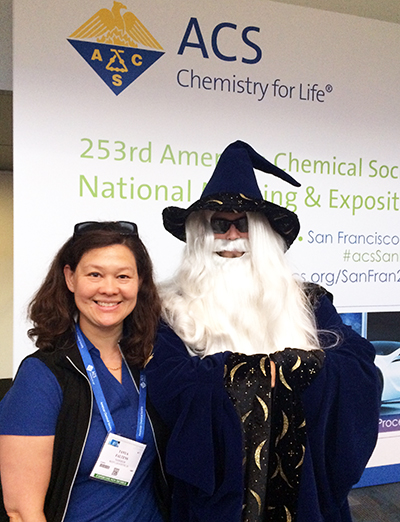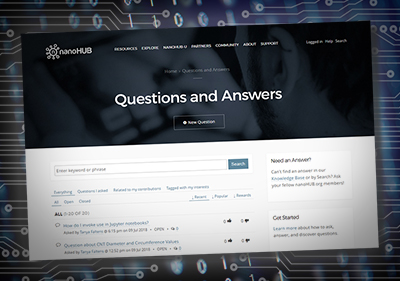 For the second year in a row, nanoHUB’s URE (Undergraduate Research Experience) program has included students from community colleges. We spoke with Professor Marcial Gonzalez and his graduate assistant Caroline Baker, both from Purdue University, to learn more about the ways in which the students have been contributing to nanotechnology research via NCN’s cyberplatform.
For the second year in a row, nanoHUB’s URE (Undergraduate Research Experience) program has included students from community colleges. We spoke with Professor Marcial Gonzalez and his graduate assistant Caroline Baker, both from Purdue University, to learn more about the ways in which the students have been contributing to nanotechnology research via NCN’s cyberplatform.
nanoHUB: Which school are you with? What is your research focus?
Caroline: We are with the School of Mechanical Engineering. Our research focus, broadly, is the study of compacted powders at high confinement, as applied across energetics, pharmaceutical, ceramics, automotive, and other industries.
nanoHUB: How many community college students are in the program, and from which community colleges are they coming?
Caroline: There are four community college students in this program this year.
Marcial: Three are coming from Pasadena City College in Pasadena, CA, and one is coming from Ivy Tech Community College of Indiana in West Lafayette.
nanoHUB: How were they chosen?
Marcial: Tanya Faltens, with the Network for Computational Nanotechnology (NCN) at Purdue University, is instrumental in identifying the best candidates for the NCN URE program. She has created a network of undergraduate mentors in a number of community colleges who interview and nominate candidates. We then review these applications and prioritize, among other things, the student’s previous research experience, and plans to transfer to a 4-year school and ultimately attend grad school.
nanoHUB: On which research projects are the community college students working? How are they using nanoHUB to accomplish their goals?
Marcial: The general theme of the research project is powder compaction, which is a manufacturing process used in many industries. The students are exposed to applications in the pharmaceutical and energy industries. For example, the solid oral tablets sold in the pharmacy are compacted powder blends, and many solid propellants are pressed nano-powders. The performance of these products is controlled by their microstructure, which is formed during the compaction process. This summer, the students have three main goals: (i) explore the use of the nanoHUB tool Powder Compaction to simulate the fabrication process, (ii) fabricate compacts using a variety of different powder blends and characterize their properties, (iii) calibrate and validate the predictions of the simulations.
nanoHUB: What will they be contributing to nanoHUB?
Marcial: The main contributions are to the nanoHUB tool Powder Compaction. The students will create a detailed protocol for generating experimental data, calibrating the model and validating its predictions. The students will also add a new feature to the compaction model that will allow the nanoHUB tool to better describe the unloading part of the compaction process.
Read more...
 Each year, the national meeting of the American Chemical Society attracts thousands of chemists, chemical engineers, students, academics, and other professionals. For the second year running, the Network for Computational Nanotechnology will also be in attendance.
Each year, the national meeting of the American Chemical Society attracts thousands of chemists, chemical engineers, students, academics, and other professionals. For the second year running, the Network for Computational Nanotechnology will also be in attendance.
From Sunday, August 19 through Tuesday, August 21, we’ll be available while the exhibit hall is open. Representatives from nanoHUB, as well as its network partners which focus on domains including nano-manufacturing and nanobio, will be on hand to answer your questions and demonstrate the use of the cyberplatform.
Stop by booth 2622 and say hello, pick up some of our giveaways and informational handouts, and learn how to accelerate research and education with chemistry and materials science simulation tools. We’d especially love to speak with those who have research code they would like to publish on nanoHUB. Hope to see you there!

If you have a question about a nanoHUB-related topic and you can’t find the answer by searching the site or browsing our Knowledge Base, try asking your fellow nanoHUB members for input.
Visit the “Questions and Answers” page and click the “New Question” button to get started. You’ll need to fill out a short form including some tags that describe the subject of your question, a brief, one-line version of your question that will be used as the title, and finally your full, detailed question. You may check the appropriate box to post anonymously if you wish.
Once you click the “Save” button your query will be visible for other members to answer. While you’re at it, why not peruse the list of questions yourself and see if you have the answer to any of them? Input from our members helps the nanoHUB community grow and contributes to new developments and discoveries in the field of nanotechnology.
